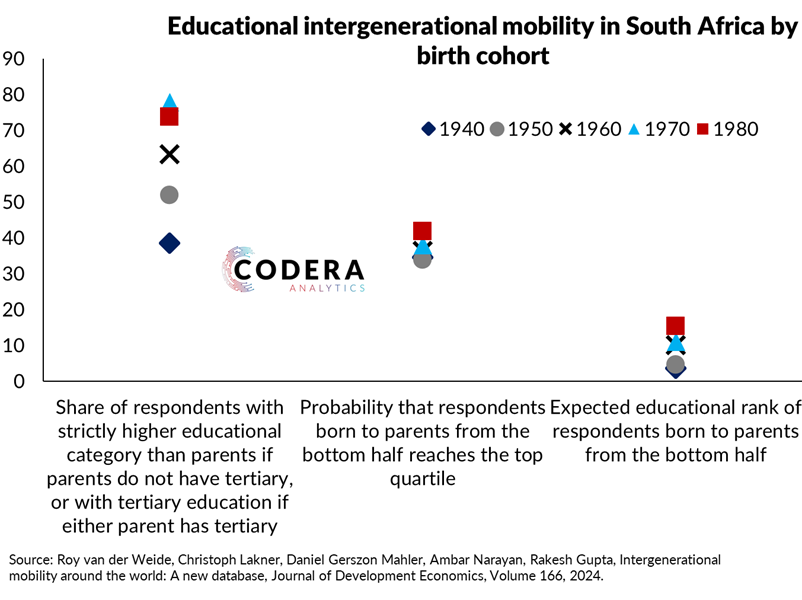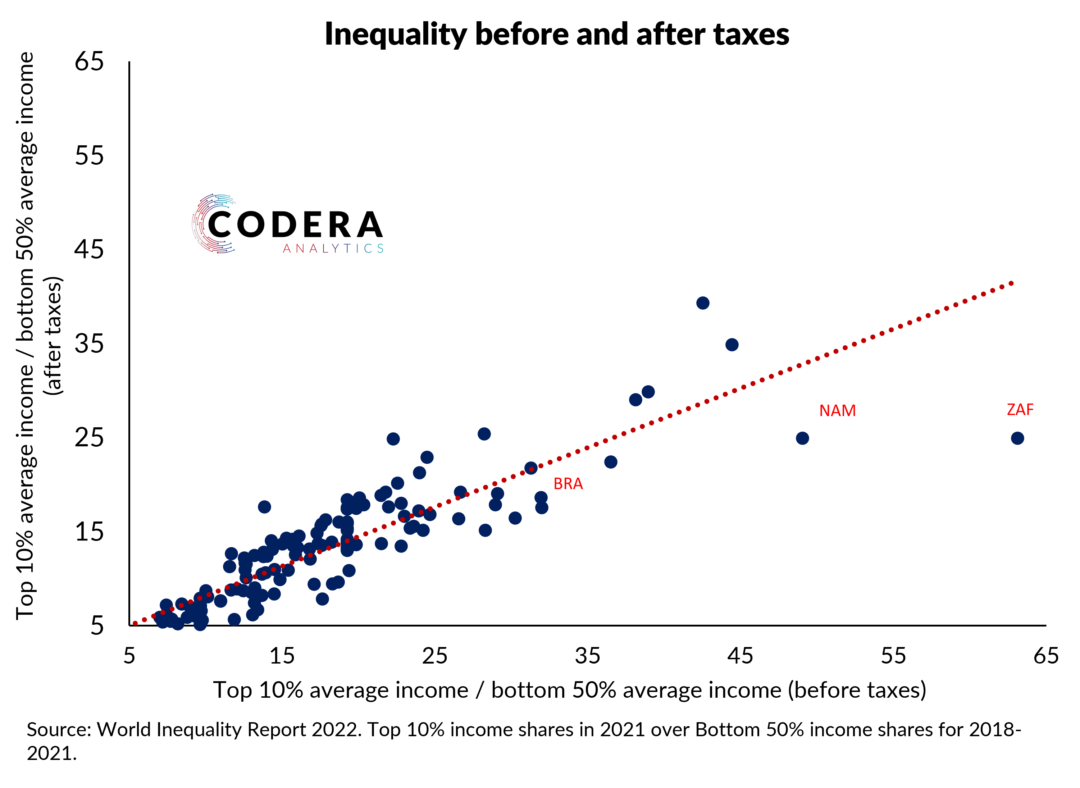Here I repost the article I co-authored on Johan Fourie’s blog.
Intergenerational mobility (IGM) refers to the ability of individuals from different family backgrounds to move up or down the social and economic ladder in a society. Essentially, it’s a measure of whether a society provides equal opportunities for everyone, irrespective of their origins. The renowned philosopher John Rawls, in his influential book ‘A Theory of Justice’, argued that a hallmark of a just society is one where individuals are afforded as many opportunities as possible, without being hindered by their social or family circumstances. The idea is simple: in a fair society, your potential shouldn’t be constrained by your family’s background. Everyone should have an equal shot at success.
The importance of studying IGM cannot be overstated. Firstly, if IGM is low, it could indicate that many individuals might not be achieving as much as they could, simply because of their family background. Think of two children: one from a well-educated family and the other from a less-educated one. If both children have the same potential, but only the one from the educated family thrives, society is missing out on valuable talent. Secondly, low IGM can hint at resources, such as quality schooling or job opportunities, being unfairly distributed based on familial ties rather than merit.
Historically, most research about IGM was centred on income and predominantly conducted in developed nations like the U.S. and Canada. These studies often found that areas with higher mobility rates usually had factors like superior public schools, more equal opportunities, and robust community bonds, promoting fair chances for everyone.
However, there was a significant gap in understanding IGM from a global educational perspective, especially in developing countries. This gap has now been addressed with the introduction of the Global Database on Intergenerational Mobility (GDIM). This massive research project, culminating in a new paper in the Journal of Development Economics, has collected data from countries around the world, providing one of the most extensive insights into educational mobility to date.
But why the emphasis on education over income? There are a couple of reasons. For starters, it’s generally easier to gather consistent data on education levels across countries compared to income levels. Moreover, educational achievements are stable; once you acquire a degree or qualification, it remains with you. In contrast, income can fluctuate over the years. Still, it’s worth noting that focusing solely on education doesn’t reveal everything. For instance, having a degree might not guarantee the same job opportunities everywhere, especially if job access is influenced by a person’s family background.
So, what does intergenerational education mobility look for South Africa in comparison to other countries?
The chart we’re looking at presents three interesting measures from the study:
- The likelihood that children will go on to achieve a higher level of education than their parents did.
- Where these children are expected to rank in terms of education compared to their peers in their generation.
- The estimated percentage of individuals, based on survey data, who manage to reach the top 25% in terms of years spent in education among their age group, especially when they come from families where their parents were in the lower 50% for education in their own time.

It shows that people in South Africa born in the 1980s had a better chance of improving their educational status compared to those born in the 1940s, based on all three measures from the study. Interestingly, while those born in the 1970s were most likely to achieve a higher level of education than their parents, the 1980s group scored highest in the other two measures. This implies that more recent generations have been increasingly successful at outdoing their parents in terms of education.

How does South Africa stack up in terms of intergenerational mobility when compared to other countries? The second chart offers a glimpse by comparing South Africa’s 1980-born individuals to their peers in other BRICS nations. Impressively, South Africa tops the list in two of the measures, as represented by the dark blue and light blue markers. However, when it comes to the indicator shown by the red marker, Brazil takes the lead.
And how does South Africa measure up against developed nations in terms of intergenerational mobility? The third chart contrasts South Africa with a handful of advanced economies. Canada comes out on top for one of the indicators, shown by the red marker, while New Zealand shines the brightest for the other two, depicted by the dark blue and light blue markers. Notably, South Africa stands tall, outpacing the US in all three metrics.

Yet, there is an important nuance to consider. Owing to the impact of Bantu Education, the earlier generation in South Africa faced severely limited educational opportunities, setting a low baseline for comparison. As a result, the high intergenerational educational mobility for the 1970s and 1980s cohorts might not be as surprising as it first appears. What would be truly revealing would be insights into the mobility trends post-1994, after the end of apartheid. Unfortunately, this dataset doesn’t offer that perspective, leaving us with a lingering question about the recent trends.
South Africa is an outlier on the continent; aside from South Africa, African countries perform poorly. Says the authors:
Sub-Saharan Africa stands out as the region where children have been least successful at surpassing their parents. In some of the poorest or most fragile countries in the region, the share of respondents that have more education than their parents is less than 20 percent, compared to over 80 percent in parts of East Asia.
What, then, determines the ability of children to attain better education than their parents?
Although the authors are careful to stress that they cannot make definitive causal claims, some insights emerge when looking at the characteristics of countries with high mobility rates. Typically, these nations tend to have larger government spending, particularly on education, relative to their national income. They also display lower income disparities, enjoy more democratic governance with fewer conflict-related deaths, and have diverse populations that move around a lot. Such countries also seem to prioritise child health, evident from lower rates of health issues like stunting among children, and they invest in education, as shown by a higher teacher-to-student ratio and fewer students leaving school prematurely. However, while these findings provide clues, they are preliminary, and more research is needed to confirm these associations.
Additionally, the relationship between a country’s income and intergenerational mobility offers another layer of complexity. In extremely poor countries, many parents might lack formal education, making it easier for the next generation to surpass them, suggesting high mobility. Yet, as nations develop, educational differences among parents become clearer. A child’s educational path might then depend more on whether they’re from a poor, middle-class, or wealthy background, possibly leading to reduced mobility. This trend might reverse when richer countries use their wealth to balance out private investment inequalities. However, the stark contrast in mobility between developed and developing countries isn’t just about government spending – there are other factors at play that need further exploration.
One possibility, reported in a new Nature paper, is that the relative education of today’s fathers and mothers matters. The study reports that:
With the prevalence of hypogamous parents (mother more educated), mother-child associations are stronger, but father-child associations are weaker. With the prevalence of hypergamous parents (father more educated), mother-daughter associations are weaker.
It’s clear that the causes of intergenerational mobility are complex and context-specific.
While cross-country comparisons are useful, within-country comparisons might be even more relevant, particularly in the case of South Africa. It remains crucial, in the face of alarming unemployment rates and significant income inequality, to understand how mobility varies across the nation’s diverse racial landscape. Several strategies could propel forward mobility for younger generations, like enhancing educational quality, mitigating crime, and optimizing healthcare spending.
Yet, at the heart of it all, the pressing need for job creation through robust economic growth remains paramount. As a salve to so many of South Africa’s qualms, the country must prioritise reforms that stimulate economic growth and open doors to employment opportunities.
With Prof Johan Fourie, Stellenbosch University
Footnote
Guided by the authors, we take the middle ground between the highest and lowest chances that someone, born to parents from lesser opportunities, can reach the top tier of education. This average reflects both men and women.

